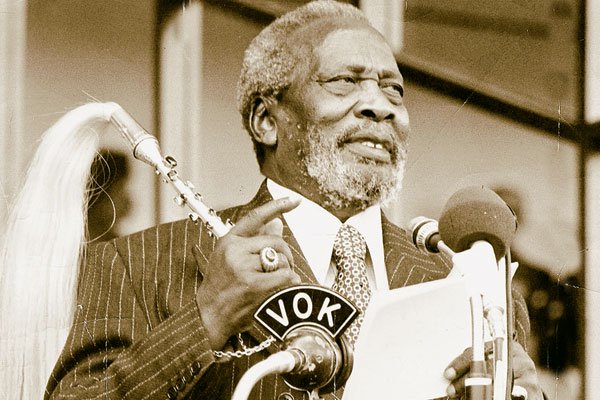It was early morning on July 15, 1964. Jomo Kenyatta, then Prime Minister of Kenya, was in London during the Commonwealth Prime Minister’s Summit when he became a target of what was described as a racist attack.
Britain had then called a conference of South Rhodesians, black and white, to talk about terms on which the self-governing colony would achieve independence.
That morning, Kenyatta was making his way through the lobby of the Hilton Hotel in London when he was attacked by a young white man.
According to The New York Times, as the Kenyan leader emerged from the hotel, John Tyndall, a 30-year old white man, who was an official of the British National Socialist Movement, started screaming through a megaphone from the opposite side of Park Lane.
“Kenyatta, go back to Africa!” he shouted.
That moment, a 21-year-old physician’s clerk, Martin Allen Webster, ran towards the 74-year-old Kenyan leader as he was about to step into his automobile. Webster bumped a policeman and jumped on the Kenyan leader.
The policeman then turned and grabbed Webster, and all three men fell on the car, denting it on the side and damaging the open door. As the policeman, a chauffeur and British and Kenyan security officers wrestled with Webster, Tyndall’s voice rose.
“This is the man who murdered our white brethren in Africa!” he screamed.
He was basically referring to the Mau Mau, a major nationalist revolutionary movement that originally sought to reclaim land that the British settlers had taken away from them in the 1950s.

The group would eventually contribute to Kenya’s independence. Kenyatta was linked to the group. Despite little evidence connecting Kenyatta to the “Kapenguria Six” – the individuals accused of leading the Mau Maus, Kenyatta spent nine years in prison.
After the racist attack, Webster and Tyndall were arrested by the police. Kenyatta issued a statement saying he was “completely unhurt,” and urged the people of Kenya to “remain calm and not rely on possible exaggerated reports.”
Dr. J. Njuguna Karanja, Kenya’s High Commissioner in London, meanwhile, launched a formal protest with the Commonwealth Relations Office, complaining of inadequate security.
Sir Alec Douglas‐Home, the British Prime Minister also issued a statement of how “greatly distressed” he was after being told of the “deplorable attack.”
Webster later appeared in court on charges of having assaulted Kenyatta and a policeman and having used threatening behaviour with intent to provoke a breach of the peace.
Tyndall was charged with having used insulting words that could have led to a breach of the peace. The two men were released on bail, according to the report by The New York Times.
This was not the first time that British extremists had directly targeted Kenyatta. Earlier in 1962 while on a visit to London for the Lancaster Conference, he was pelted with rotten eggs by white extremists holding placards that read “HANG KENYATTA.’
Some sources said he was pelted with fresh ones as he went in and rotten ones while he left.
Kenyatta, who led Kenya from its independence in 1963, ushered in a new change for the nation after years of British rule. While in office as the country’s first president, his health had become poor in 1966 when he suffered a heart attack.
He ruled, however, as a leader open to reconciliation with the British and Asian settlers in the land. Kenyatta embraced a capitalist model of the government, although some experts write that he selfishly promoted those from his own circle and tribal line to positions of power.
Still, Kenyatta was beloved by many all the same, despite the rumblings that in his later years he had no control over government affairs due to his failing health.
While still in office, Kenyatta died on this day in 1978, leaving behind a legacy that has been both praised and criticized.










